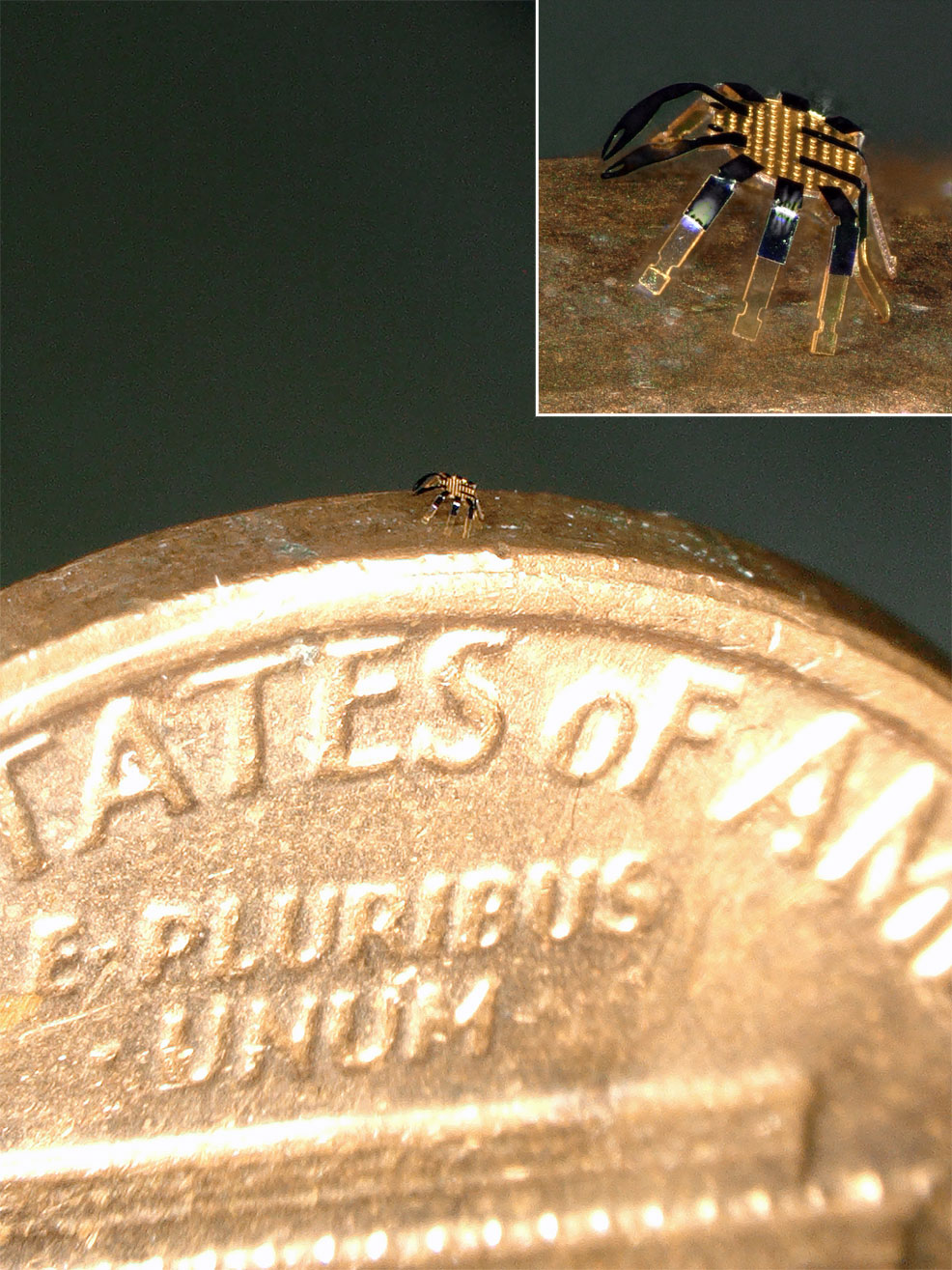- Luật
- Hỏi đáp
- Văn bản pháp luật
- Luật Giao Thông Đường Bộ
- Luật Hôn Nhân gia đình
- Luật Hành Chính,khiếu nại tố cáo
- Luật xây dựng
- Luật đất đai,bất động sản
- Luật lao động
- Luật kinh doanh đầu tư
- Luật thương mại
- Luật thuế
- Luật thi hành án
- Luật tố tụng dân sự
- Luật dân sự
- Luật thừa kế
- Luật hình sự
- Văn bản toà án Nghị quyết,án lệ
- Luật chứng khoán
- Video
- NGHIÊN CỨU PHÁP LUẬT
- ĐẦU TƯ CHỨNG KHOÁN
- BIẾN ĐỔI KHÍ HẬU
- Bình luận khoa học hình sự
- Dịch vụ pháp lý
- Tin tức và sự kiện
- Thư giãn

TIN TỨC
fanpage
Thống kê truy cập
- Online: 223
- Hôm nay: 198
- Tháng: 1621
- Tổng truy cập: 5245625
Worlds smallest remote-controlled walking robot
The world's smallest remote-controlled walking robot, just 0.5 mm wide, has been demonstrated by Northwestern University. Its potential applications include the clearing of blocked arteries.

The world's smallest remote-controlled walking robot, standing on the edge of a coin. Credit: Northwestern University
Engineers at Northwestern University, Illinois, have developed the smallest-ever remote-controlled walking robot – tiny enough to stand on the edge of a coin, needle, or ballpoint pen. With eight legs and two frontal claws, it resembles a miniaturised crab.
The robot can bend, twist, crawl, walk, turn, and even jump. Although the research is exploratory at this stage, the team behind it believe their technology could lead to micro-sized robots able to perform a variety of tasks inside tightly confined spaces. They are also developing millimetre-sized robots resembling inchworms, crickets, and beetles. Their work is published this week in the journal Science Robotics.
"Robotics is an exciting field of research, and the development of microscale robots is a fun topic for academic exploration," said John Rogers, Professor of Materials Science and Engineering, who led the study. "You might imagine micro-robots as agents to repair or assemble small structures or machines in industry or as surgical assistants to clear clogged arteries, to stop internal bleeding or to eliminate cancerous tumours, all in minimally invasive procedures."
"Our technology enables a variety of controlled motion modalities and can walk with an average speed of half its body length per second," said Yonggang Huang, Professor in Mechanical Engineering, who led the theoretical side of the research. "This is very challenging to achieve at such small scales for terrestrial robots."

Credit: Northwestern University
No complex hardware, hydraulics or electricity is required by the robot. Instead, its power lies in the elastic resilience of its body. To construct it, the team used a shape-memory alloy material that transforms to its "remembered" shape when heated. In this case, they used a scanned laser beam to rapidly heat the robot at different targeted locations across its body. A thin coating of glass elastically returns that corresponding part of structure to its deformed shape upon cooling.
As the robot changes from one phase to another – deformed to remembered shape and back again – it creates locomotion. Not only does the laser remotely control the robot to activate it, but the laser scanning direction also determines the robot's walking direction. Scanning from left to right, for example, causes the robot to move from right to left.
"Because these structures are so tiny, the rate of cooling is very fast," explained Rogers. "In fact, reducing the sizes of these robots allows them to run faster."
To manufacture such a tiny robot, the scientists used a "pop-up" assembly method inspired by a child's pop-up book. First, they fabricated precursors to the walking crab structures in flat, planar geometries. Then, they bonded these onto a slightly stretched rubber substrate. When the stretched substrate is relaxed, controlled buckling occurs and causes the crab to "pop up" into precisely defined 3D forms.
"With these assembly techniques and materials concepts, we can build walking robots with almost any sizes or 3D shapes," said Rogers. Explaining the choice to design crabs, he added: "But the students felt inspired and amused by the sideways crawling motions of tiny crabs. It was a creative whim."
By FutureTimeLine
Các bài viết khác
- Vài nét Dự báo thời đại phục hưng và khai sáng của loài người sau đại dịch Corona-2019.7-2021(khởi đầu từ tháng 9 năm giáp thìn 2024) (25.06.2021)
- Từ sự kiện Tổng biên tập báo TIME Greta Thunberg là Nhân vật của năm 2019 đến báo cáo Biến đổi khí hậu Phúc trình của IPCC báo động đỏ cho nhân loại 82021 (15.01.2020)
- The Mind Is More Than A Machine (23.06.2022)
- The world faces a growing stagflationary storm (23.06.2022)
- Có nên xuống tiền mua bất động sản lúc này? (23.06.2022)


















































 Yahoo:
Yahoo: 